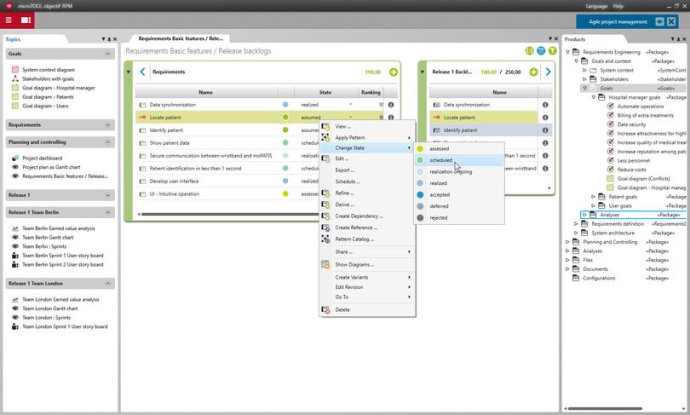objectiF RPM simplifies agile development by making requirements management easier. It helps overcome the challenge of eliciting requirements for software and system development. This software is instrumental in achieving successful agile development by placing emphasis on requirements management.

The Software for Application Lifecycle Management is an all-in-one solution that combines various approaches to manage application development. This includes model-based requirements engineering, system design, agile, and classic project management approaches, as well as agile testing.
Features:
One of the key highlights of this software is its visual requirements analysis and specification tools. These tools assist in the creation of use case modeling, block diagrams, class diagrams, package diagrams, requirement diagrams with UML, SysML, and other requirement documentation. Users can edit states, priorities, and workloads, as well as interdependencies between requirements and other system elements.
Task and project planning can be accomplished using an agile, classic, or hybrid approach. Planning is derived straight from the requirements. The software offers features like a roadmap for release planning, Gantt chart scheduling, cost and progress controls, import and export of MS Excel files, and ReqIF and JIRA interfaces. All project results are traceable all the time thanks to integrated configuration and variant management.
Reporting:
Users can generate presentable reports at any given time by utilizing the software’s various dashboards, queries, and views. These reports can be used for project controlling purposes.
Collaboration:
The software offers a common environment for team collaboration via client-server or web-client access. This allows for seamless communication and coordination among team members.
Conclusion:
The Software for Application Lifecycle Management is a tool of the newest generation. It’s scalable, integrative, adaptable, and extendable with modern architecture. It is an ideal solution for managing application development projects for companies of all sizes.
Version 5.2:
Multi-Gantt-Chart
cross-project requirements engineering
Kanban board for stereotypes
resource management improved
Version 5.1:
New control elements for revisions
Create forms for relationships
Define snippets for forms, text fields and memos
Define default values for properties
Sort and edit enumeration values
Set up automatic revisions for changes
Move or copy artifacts using drag & drop
Create patterns
And more!
Version 5.0: new features for requirements traceability to code, deployment, customizing and creating extensions, e.g. APIs and individual functions
Version 4.4: new framework for digital transformation, new patterns and more features for improved usability
Version 4.3: The current release offers a new rights-management which gives individual members of the project staff specific suitable access rights and views. Additionally to the already existing import from MS Excel, ReqIF and Jira, requirements can now also be imported from MS Word and more.
Version 4.2:
New state machine actions,
improved form designer
variant management,
bug-fixes
Version 4.0:
New option to expand the data models for your own artifacts and relationships.
Form designer for artifacts and previous model elements.
New view - cumulative flow diagram.
Data exchange with Atlassian JIRA.
Support of variations in backlogs.
And more improvements, new features and bug fixes!
Version 3.3:
Generate precedence diagram: you can now generate individual sheet activities as a netplan to Visio or as a PDF. The command Generate precedence diagram will appear in as an activity in the context menu.
• Task Manager: There is now a task manager for organizations and projects that offers tasks
Version 3.2: Dashboards for projects, releases, teams and sprints. Improved UML and SysML diagram import, improved linking between backlogs and activities.